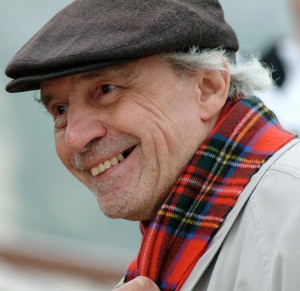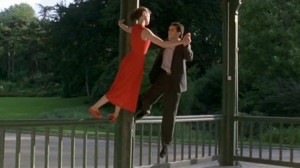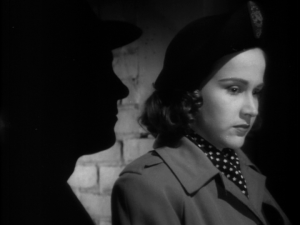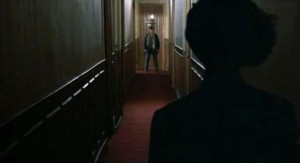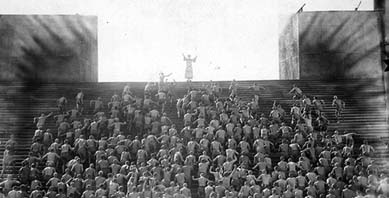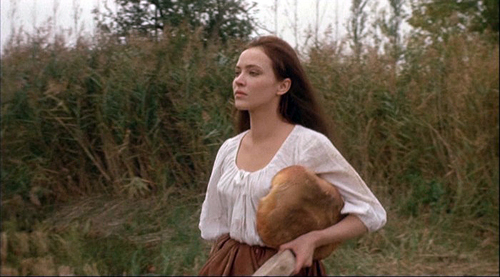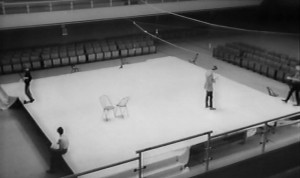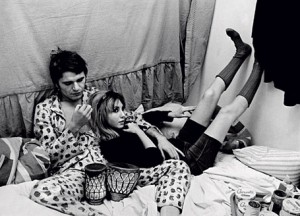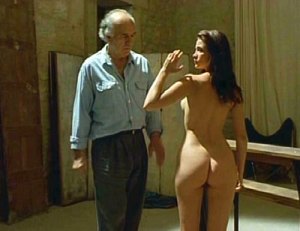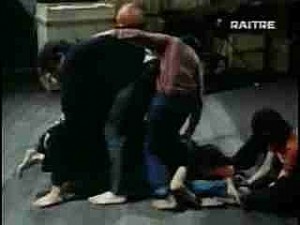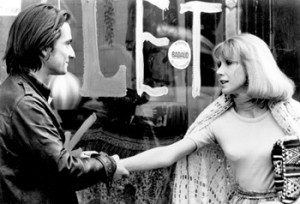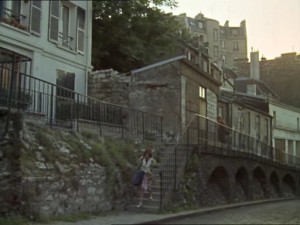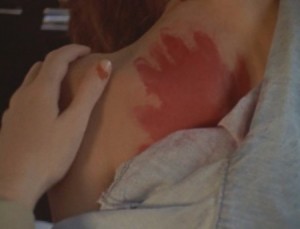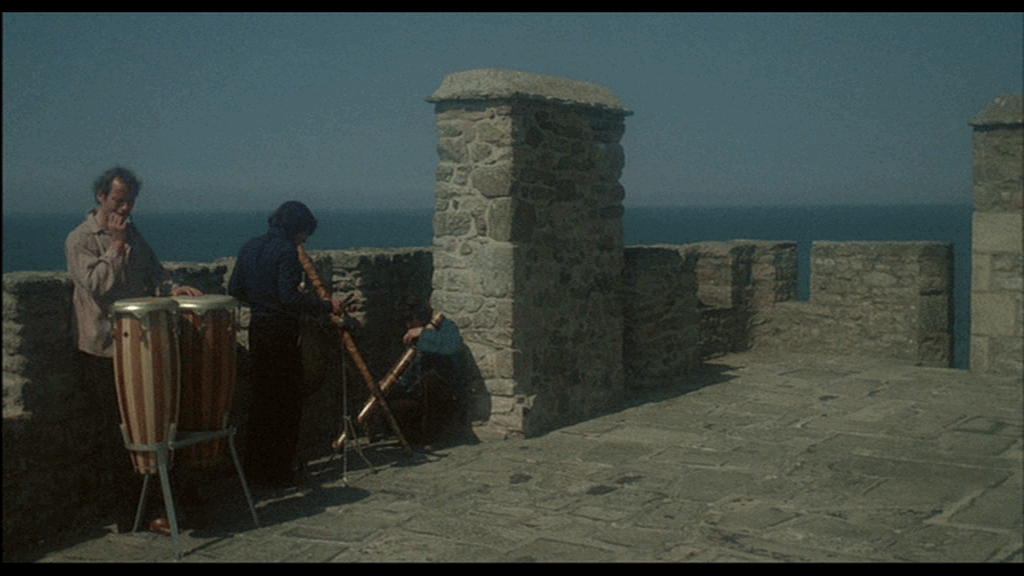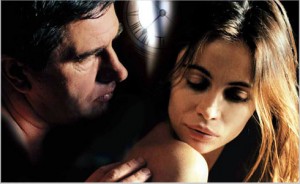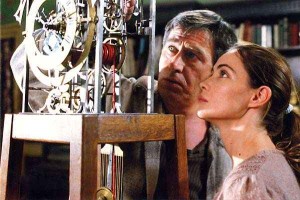An essay written for Toronto’s Cinematheque Ontario program guide (February 2007). –- J.R.
For better and for worse, and principally the latter, Jacques Rivette has been singled out as the former Cahiers du Cinema film critic who makes the least commercial films, as well as the longest ones. But for the record, the films of the always-neglected Luc Moullet [screened in Cinematheque Ontario’s Spring 2006 season –- ed.] are generally less commercial than those of Rivette. And even what we mean when we say “longest films” is open to some debate. (After all, the over twelve-hour OUT 1: NOLI ME TANGERE was conceived as a TV serial, and Jean-Luc Godard’s own first TV series, made a few years later, was just as long.)
The problem with such caricatures is they generally function as excuses for why some spectators won’t deal with Rivette’s films rather than as viable descriptions of what they offer. Yes, his features tend to be long and they work with duration. Furthermore, when two versions have been made of some of them –- unauthorized in the case of L’AMOUR FOU, authorized in the cases of L’AMOUR PAR TERRE and LA BELLE NOISEUSE/ DIVERTIMENTO – the longer version is almost always superior. (The only arguable exception to this rule is the two versions of OUT 1, both authorized, which are too distinct as well as too complementary in conception to be thought of as competitive.)
Let me propose a few other traits that make Rivette stand out among his former critical colleagues. According to François Truffaut, he was the one who was most determined to become a filmmaker. He’s also the one most interested in actors — even if this only started to become apparent with his second feature, when he could afford to hire professionals. I’d also argue that, along with Godard, he is the only one who has continued to be a critic as well as something of a theorist while functioning as a filmmaker — someone whose memory of other films and filmmakers often shapes his meanings, so that, for instance, GIVE A GIRL A BREAK served as a kind of working model for HAUT/BAS/FRAGILE, just as THE SEVENTH VICTIM was a starting point for DUELLE. (Regarding Rivette’s appreciation of Hollywood, the 1974 CELINE ET JULIE VONT EN BATEAU offers especially exuberant testimony. )
This latter tendency is already apparent in his first feature, PARIS NOUS APPARTIENT (1960), when a group of friends are screening a print of METROPOLIS. Not only does Lang’s Tower of Babel sequence comment on the complex paranoid plot of Rivette’s film; once the film breaks and we’re briefly confronted with a blank screen, this detail is equally pertinent. And in a way the dialectic present here between multiple languages and gaping void -– too much significance and too little — is basic to Rivette’s cinema as a whole.
***
His second feature, LA RELIGIEUSE (1966) provoked a scandal when it was banned by the Gaullist government for its adaptation of Denis Diderot’s anticlerical novel. Yet apart from its modernist soundtrack, it seems like a throwback to classical narrative in relation to the radical experimentation that precedes and immediately follows it (which for me figures as most potent and exciting stretch in Rivette’s work — roughly 1968-81). But insofar as this film highlights Rivette’s interest in what might be called “classical” mise en scène, which has dominated his work over the past quarter of century, it no longer looks like a detour; among its most obvious successors are JEANNE LA PUCELLE (1994) and SECRET DEFENSE (1998), both vehicles for Sandrine Bonnaire, and HURLEVENT (1985) – another period literary adaptation, this time of Wuthering Heights.
But it’s only with Rivette’s three-part TV documentary JEAN RENOIR, LE PATRON (1966) that his formal agenda shifts and the creative contributions of actors become central, yielding the bold experiment of L’AMOUR FOU(1969). By Rivette’s own account, it was partially the experience of editing Renoir clips that prompted this change, though his work with Andre S. Labarthe, co-producer of the Renoir series, who shot the 16mm footage of L’AMOUR FOU -– also clearly played a role.
Alternating between Labarthe’s 16mm cinéma-vérité footage of theater rehearsals af Andromaque directed by Jean-Pierre Kalfon and Rivette’s 35mm footage of the same rehearsals, meanwhile inviting Kalfon and Bulle Ogier to play a tormented fictional couple and generate much of their own characters and dialogue (which was also shot in 35mm), Rivette deliberately made his own position as spectator relatively passive, postponing his role as final arbiter to the editing stage. One might therefore postulate that Renoir and his own love of actors stands for the Babel side of the Rivettean dialectic, dominant during shooting, where too many meanings fight for supremacy, and the more misanthropic Lang stands for the void, articulated during editing, when most of the meanings get pared away.
Eventually, this shift would mean that Rivette’s films would become defined mainly by their actors — and, in particular, their actresses. Arguably, LA BELLE NOISEUSE (1991) becomes even more a film about Emmanuelle Béart than a Balzac adaptation or a film about painting. L’AMOUR PAR TERRE (1984) is basically a meditation on Jane Birkin and Geraldine Chaplin, LA BANDE DES QUATRE (1988) is above all a film about Bulle Ogier, Laurence Côte, and Nathalie Richard, among others, and VA SAVOIR (2001) ultimately has more to do with Jeanne Balibar than with Luigi Pirandello.
The experiment of L’AMOUR FOU was expanded in the two versions of OUT I — a post-1968 meditation on solitude and collectivity that returned to the themes of Rivette’s first feature, focusing again on both theater rehearsals and fantasies and/ or intimations of conspiracy, but this time inviting all the actors to generate their own characters and dialogue. And the experiment underwent further developments once Rivette decided to edit the results into two quite different features in which the placement, function, and meaning of certain shots differed.
By now, it might be said that actors had taken over Rivette’s cinema during the shooting stage — a freedom underwritten by the radical premise that anything and everything an actor does is potentially interesting, so that even a “bad” performance in OUT 1 can potentially be as interesting for what it reveals as a “good” one, and mixing seemingly incompatible acting styles becomes part of the interest. (This also has some effect on Rivette’s framing, discussed with Serge Daney in Claire Denis’ excellent 1990 documentary JACQUES RIVETTE, LE VEILLEUR). Enlisting actors as co-writers — as he would do again in CELINE ET JULIE VONT EN BATEAU, his most popular film of this period, as well as in the much later HAUT/BAS/FRAGILE (1995) -– was then succeeded by obliging actors to stick to a fixed text in most of his subsequent featureswhile seeking to solicit their creativity in other ways. In DUELLE and NOROÎT (both 1976), where live improvising musicians share screen space with the actors, the creative expressiveness becomes gestural.
Conceived as the second and third parts of a projected four-feature series entitled SCÈNES DE LA VIE PARALLÈLE, which were meant to be shot in swift succession, each film belonging to a separate genre, DUELLE and NOROÎT both employ the same invented mythology involving goddesses of the sun and moon who struggle competitively for the means to remain on Earth past an allotted forty-day period.
Suffering a nervous collapse shortly after he began shooting the projected first part, entitled MARIE ET JULIEN, with Leslie Caron and Albert Finney, Rivette was forced to abandon the series, although his subsequent MERRY-GO-ROUND (1993) and HISTOIRE DE MARIE ET JULIEN (2003) represent separate attempts to bring this unrealized project to some sort of closure. The latter in particular –- in which Béart figures as the designated goddess/ghost, and the hero (Jerzy Radziwilowicz), Rivette’s surrogate, is a solitary figure who repairs clocks – offers a suggestive combo that seems to bring certain aspects of Rivette’s cinema full circle. -– Jonathan Rosenbaum

